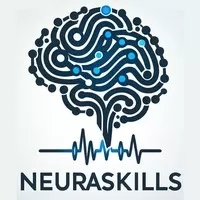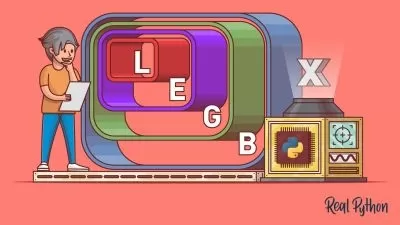EEG/ERP Analysis with Python and MNE: An Introductory Course
Neura Skills
7:44:41
Description
From Brain Signal Basics to Advanced Analysis
What You'll Learn?
- Understanding the Basics of Electrophysiology Data
- Start Working with Python
- Gain Expertise in Frequency Domain Analysis of Electrophysiological Data
- Learn to Identify and Analyze ERPs
- Acquire the Practical Skills to Conduct Time-Frequency Analysis using Python and the MNE library.
Who is this for?
What You Need to Know?
More details
DescriptionWhether you're a novice in the field or looking to enhance your skills, this course is your gateway to understanding the basics of EEG data analysis.
A Journey Through EEG History: Join us on a fascinating exploration of the origins of EEG data, from its introduction to the cutting-edge techniques used today.
Recording EEG Data: Learn the essentials of recording high-quality EEG data and what constitutes good EEG data. Learn the basics of artifacting, recognizing different types of noises, and witness noise reduction in action through various filtering techniques.
Frequency and Time Domain Analyses: Demystify the complexities of frequency and time domain analyses. Understand different brain frequencies, conduct frequency analysis, explore time domain analysis and Event-Related Potentials (ERPs), and venture into time-frequency analysis.
Python for EEG Analysis: Familiarize yourself with Python basics, ANACONDA installation, coding fundamentals, and data plotting. Install MNE (MNE-Python) and kickstart your journey into EEG analysis.
MNE-Python Pre-processing: Explore MNE-Python for pre-processing EEG data. Import data, gain an overview, implement filtering, reject bad channels, and perform Independent Component Analysis (ICA) for noise removal.
Frequency Analysis with Python and MNE: Utilize MNE's PSD function for frequency analysis. Create visually stunning frequency band plots and topographic maps to explore the mysteries hidden within EEG data.
Exploring Important ERPs: Review essential Event-Related Potentials (ERPs), such as the P300 and N170 components, along with language-related components. Understand their significance and applications in EEG analysis.
ERP and Time-Frequency Analysis in Python and MNE: Master the art of visualizing ERPs using Python. Leverage MNE for interpreting ERPs and delve into plotting and interpreting time-frequency analyses.
Why Choose This Course:
This course is designed for beginners, providing a seamless transition from the basics to advanced EEG analysis techniques. With hands-on Python coding exercises and practical examples using MNE-Python, you'll gain practical skills that are essential for anyone seeking proficiency in EEG data analysis.
Join us on this educational journey, and let's unravel the mysteries of EEG together! Enroll now to kickstart your EEG analysis adventure.
Who this course is for:
- This course is intended for a diverse range of learners who have an interest in electrophysiology data analysis, regardless of their background or experience.
- Beginners in Electrophysiology: Individuals who are new to the field of electrophysiology and want to understand the fundamentals and practical aspects of data analysis will find this course to be an excellent starting point.
- Students and Researchers: Undergraduate and graduate students, as well as researchers in fields such as psychology, neuroscience, cognitive science, or related disciplines, who want to incorporate electrophysiological data analysis into their studies or research projects.
- Curious Minds: Individuals with a general interest in the brain, cognitive processes, or the applications of data analysis in scientific research will find the course engaging and informative.
Whether you're a novice in the field or looking to enhance your skills, this course is your gateway to understanding the basics of EEG data analysis.
A Journey Through EEG History: Join us on a fascinating exploration of the origins of EEG data, from its introduction to the cutting-edge techniques used today.
Recording EEG Data: Learn the essentials of recording high-quality EEG data and what constitutes good EEG data. Learn the basics of artifacting, recognizing different types of noises, and witness noise reduction in action through various filtering techniques.
Frequency and Time Domain Analyses: Demystify the complexities of frequency and time domain analyses. Understand different brain frequencies, conduct frequency analysis, explore time domain analysis and Event-Related Potentials (ERPs), and venture into time-frequency analysis.
Python for EEG Analysis: Familiarize yourself with Python basics, ANACONDA installation, coding fundamentals, and data plotting. Install MNE (MNE-Python) and kickstart your journey into EEG analysis.
MNE-Python Pre-processing: Explore MNE-Python for pre-processing EEG data. Import data, gain an overview, implement filtering, reject bad channels, and perform Independent Component Analysis (ICA) for noise removal.
Frequency Analysis with Python and MNE: Utilize MNE's PSD function for frequency analysis. Create visually stunning frequency band plots and topographic maps to explore the mysteries hidden within EEG data.
Exploring Important ERPs: Review essential Event-Related Potentials (ERPs), such as the P300 and N170 components, along with language-related components. Understand their significance and applications in EEG analysis.
ERP and Time-Frequency Analysis in Python and MNE: Master the art of visualizing ERPs using Python. Leverage MNE for interpreting ERPs and delve into plotting and interpreting time-frequency analyses.
Why Choose This Course:
This course is designed for beginners, providing a seamless transition from the basics to advanced EEG analysis techniques. With hands-on Python coding exercises and practical examples using MNE-Python, you'll gain practical skills that are essential for anyone seeking proficiency in EEG data analysis.
Join us on this educational journey, and let's unravel the mysteries of EEG together! Enroll now to kickstart your EEG analysis adventure.
Who this course is for:
- This course is intended for a diverse range of learners who have an interest in electrophysiology data analysis, regardless of their background or experience.
- Beginners in Electrophysiology: Individuals who are new to the field of electrophysiology and want to understand the fundamentals and practical aspects of data analysis will find this course to be an excellent starting point.
- Students and Researchers: Undergraduate and graduate students, as well as researchers in fields such as psychology, neuroscience, cognitive science, or related disciplines, who want to incorporate electrophysiological data analysis into their studies or research projects.
- Curious Minds: Individuals with a general interest in the brain, cognitive processes, or the applications of data analysis in scientific research will find the course engaging and informative.
User Reviews
Rating
Neura Skills
Instructor's Courses
Udemy
View courses Udemy- language english
- Training sessions 43
- duration 7:44:41
- Release Date 2024/05/04










